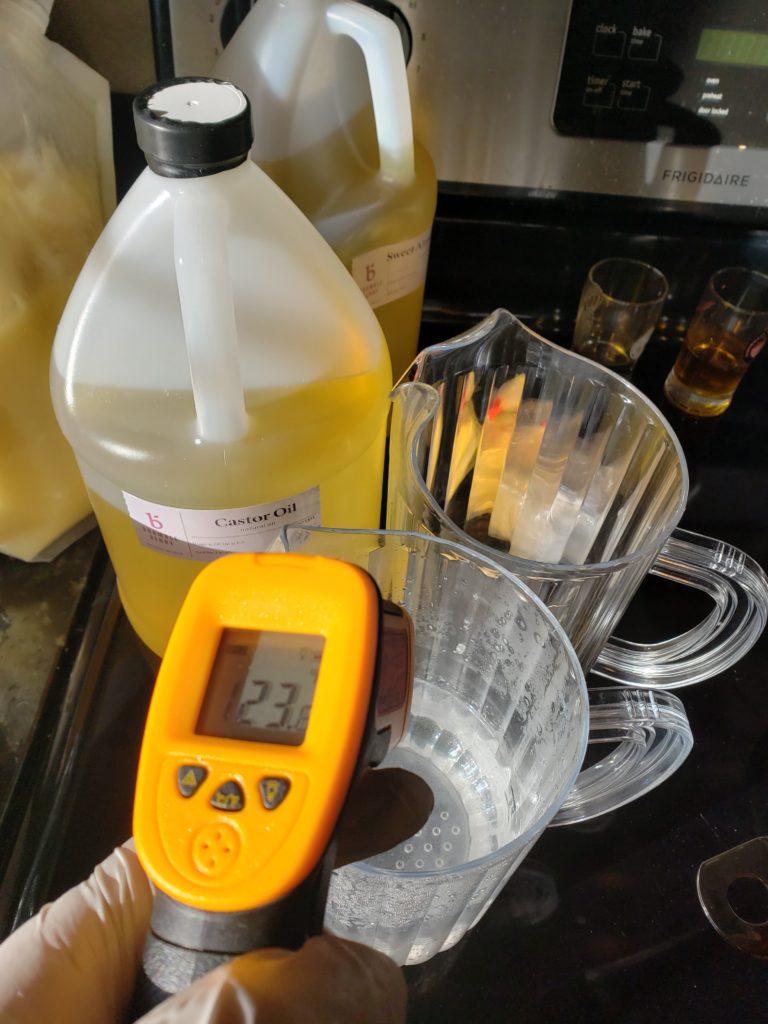I’ve been thinking about making cold process soap for years and I often watch videos on soap design on YouTube. When my friend asked me to pick up his favorite coconut soap while I was at the store and I found it was $5+ a bar! $20 in soap later, I decided it was finally time to give it a shot.
Most of the materials below will either link you to Bramble Berry or Amazon. These were the two main shopping sources I used to buy my materials. Bramble Berry is a popular supplier and also happens to be local, so I knew my shipping would be relatively fast.
You should keep in mind that most of the equipment you use will come in contact with lye and should be dedicated to soap making. Don’t eat from, drink from or make food with these tools or in these containers afterwards.
Required Materials
Silicone Soap Mold – or some form to pour your soap mixture into. Some people use milk cartons or PVC piping, but the most common is a rectangular “loaf” mold. The loafs I picked will hold about 2 lbs of soap.
Lye – I liked this listing on Amazon, because it came with a soap mold, which is great in case you have extra soap. You can use this free mold for the overflow.
Goggles (or glasses) – you don’t want lye in your eyes.
Gloves – keep lye off your skin
Kitchen scale – every ingredient will be weighed.
Respirator mask – don’t inhale lye vapors
Oils – You can use many different types of oils and each will have a different effect on the skin. The most common soap recipes I’ve come across often include olive oil, coconut oil, palm oil, and castor oil.
Mixing Containers – I’m using some plastic pitchers but some people use gallon buckets. You’ll need at least one container capable of holding boiling water. If you want to play with multiple colors in your soap, then you’ll need a few extra for each color.
Thermometer – The infrared thermometers seem to be preferred as they won’t come in contact with your lye.
A pot to heat your oils.
A spritzer with rubbing alcohol.
Optional Materials
Soap Cutter – You’ll want a way to cut your soap unless you poured individual bars. You could also use a knife, a wire cutter (like you’d use in pottery), or any number of things. But you’ll probably get the best results from an actual soap cutter.
Colorants – Most oils are yellow. Depending on the oils you use, you may end up with a yellowish bar of soap. You may wish to at least color it white with Titanium Dioxide pigment.
Fragrance oils or Essential Oils – Be sure to read up on the oil of your choosing. Some oils will cause your soap mixture to gel up immediately or discolor your soap.
Let’s Make Some Soap
For the soap I’m making today, I decided to follow a simple beginner’s recipe. The recipe below should fill up one of the 2 lbs. loaf molds. I’ll be making a double batch. One loaf will be scented with Fig and the other with Coconut.
- 8 oz. Coconut Oil
- 11 oz. Palm Oil
- 15 oz. Olive Oil
- 11.2 oz. Distilled Water
- 4.8 oz. Lye
- Between 1-2 oz Fragrance Oils (1=Light, 1.5 Medium, 2=Strong)
- A teaspoon of colorant dispersed in some oil
Before you begin, it is important you understand how to work with lye and that you’ve read all the safety precautions.
Some oils, namely palm oil, will need to be warmed up prior to measuring.
Heat your whole container in hot water while you prep your other ingredients. Coconut oil can be left solid. I warm my coconut oil
because I find it easier to deal with.
Every ingredient will be weighed. Put on your gloves/goggles/respirator and measure out your water and lye. You’ll be taking these outside to mix. Mixing lye and water will cause an exothermic reaction and the mixture will become very hot and possibly boil. Slowly pour small amounts of lye into the water and stir. Do not dump all the lye in at once. Do not inhale the steam. Keep stirring until the water is clear again. Leave the lye water solution outside to cool off a little bit.
Weigh all your oils and put them in your pot. Heat up the oils to 120°F. Cold process soap is generally made between 110° and 130° though you can work colder if you wish. Both your oils and your lye water should be about this temperature and kept within 10° of each other.
While you’re bringing your oils up to temperature, you can bring your lye water in from outside before it cools off too much. It’s cold here at the moment, so it can’t stay out there too long.
When both are about 120°, it’s time to combine. Using your stick blender, pour the lye water down the stick and into the oils. This is should help avoid splashing the lye. Mix the oils and lye together just until combined.
Since I’m making a double batch, I split my soap into two different containers. One will be dyed white and scented coconut. The other a purple and scented with fig fragrance.
At this point you need to work pretty quickly. The soap will start to become more of a pudding consistency and the addition of colorants and fragrances will only speed this up more.
Add your colorant a teaspoon at a time until you reach a color you like.
Mix in your fragrance.
Pour your mixtures into your molds. Tap the molds, either on a towel or on the floor, to release any bubbles. You can see in the coconut loaf where some bubbles came to the surface.
If you want, you can play with adding texture to the top. I personally don’t care, so I’ll leave this batch alone.
Last, spritz your soap with rubbing alcohol. This will prevent the soap from forming an ash. I haven’t had this issue, but I do it anyways.
The soap will rest in the molds for about 24 hrs. Then, you can remove the silicone mold and slice the loaf into individual bars using your soap cutter. Generally, they are cut to be an inch thick. Once sliced, they should be laid out for 2 – 4 weeks to cure. It’s a long time, but your house will smell amazing while you wait.

